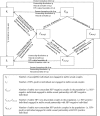Temporal evolution of HIV sero-discordancy patterns among stable couples in sub-Saharan Africa
- PMID: 29708995
- PMCID: PMC5927442
- DOI: 10.1371/journal.pone.0196613
Temporal evolution of HIV sero-discordancy patterns among stable couples in sub-Saharan Africa
Abstract
Introduction: Objective was to examine the temporal variation of HIV sero-discordancy in select representative countries (Kenya, Lesotho, Mali, Niger, Tanzania, and Zimbabwe) in sub-Saharan Africa at different HIV epidemic scales. A sero-discordant couple is defined as a stable couple (SC) in which one partner is HIV-positive while the other is HIV-negative.
Methods: A deterministic compartmental mathematical model was constructed to describe HIV transmission dynamics. The model was pair-based, that is explicitly modeling formation of SCs and infection dynamics in both SCs and in single individuals. The model accommodated for different forms of infection statuses in SCs. Using population-based nationally-representative epidemiologic and demographic input data, historical (1980-2014) and future (2015-2030) trends of sero-discordancy and other demographic and epidemiologic indicators were projected throughout HIV epidemic phases.
Results: As the epidemics emerged, about 90% of SCs affected by HIV were sero-discordant. This proportion declined to 45%-88% at epidemic peak and stabilized as the epidemics started their natural decline. The largest reductions in sero-discordancy were in high HIV-prevalence countries. As the epidemics further declined with antiretroviral therapy (ART) scale-up, the proportion of sero-discordant couples among HIV-affected couples was projected to increase to 70%-92% by 2030. The proportion of sero-discordant couples among all SCs increased as the epidemics emerged and evolved, then peaked at 2%-20% as the epidemics peaked, and then declined as the epidemics declined to reach 0.3%-16% by 2030.
Conclusions: Sero-discordancy patterns varied with the evolution of the epidemics, and were affected by both epidemic phase and scale. The largest variations were found in high HIV-prevalence countries. The fraction of stable couples that are sero-discordant, as opposed to being sero-concordant positive, was projected to increase with ART scale-up and further HIV incidence decline over the coming two decades. These findings inform strategic planning and resource allocation for interventions among sero-discordant couples.
Conflict of interest statement
Figures




Similar articles
-
Geographical Patterns of HIV Sero-Discordancy in High HIV Prevalence Countries in Sub-Saharan Africa.Int J Environ Res Public Health. 2016 Aug 31;13(9):865. doi: 10.3390/ijerph13090865. Int J Environ Res Public Health. 2016. PMID: 27589776 Free PMC article.
-
The risk of HIV transmission within HIV-1 sero-discordant couples appears to vary across sub-Saharan Africa.Epidemics. 2014 Mar;6:1-9. doi: 10.1016/j.epidem.2013.11.001. Epub 2013 Nov 19. Epidemics. 2014. PMID: 24593916
-
Modeling the impact on the HIV epidemic of treating discordant couples with antiretrovirals to prevent transmission.AIDS. 2011 Nov 28;25(18):2295-9. doi: 10.1097/QAD.0b013e32834c4c22. AIDS. 2011. PMID: 21993304 Free PMC article.
-
HIV-1-discordant couples in sub-Saharan Africa: explanations and implications for high rates of discordancy.Curr HIV Res. 2007 Jul;5(4):416-29. doi: 10.2174/157016207781023992. Curr HIV Res. 2007. PMID: 17627505 Review.
-
AIDS in sub-Saharan Africa: the epidemiology of heterosexual transmission and the prospects for prevention.Epidemiology. 1993 Jan;4(1):63-72. Epidemiology. 1993. PMID: 8420583 Review.
Cited by
-
Modeled estimates of HIV-serodifferent couples in tuberculosis-affected households in four sub-Saharan African countries.PLOS Glob Public Health. 2024 May 2;4(5):e0002609. doi: 10.1371/journal.pgph.0002609. eCollection 2024. PLOS Glob Public Health. 2024. PMID: 38696500 Free PMC article.
-
Frequency of HIV serodifferent couples within TB-affected households in a setting with a high burden of HIV-associated TB.BMC Infect Dis. 2023 Jun 9;23(1):388. doi: 10.1186/s12879-023-08365-y. BMC Infect Dis. 2023. PMID: 37296396 Free PMC article.
-
"First was to sit down and bring our minds together". A qualitative study on safer conception decision-making among HIV sero-different couples in Zimbabwe.Sex Reprod Health Matters. 2024 Dec;32(1):2366587. doi: 10.1080/26410397.2024.2366587. Epub 2024 Jul 15. Sex Reprod Health Matters. 2024. PMID: 39007699 Free PMC article.
References
-
- Lingappa JR, Lambdin B, Bukusi EA, Ngure K, Kavuma L, Inambao M, et al. Regional differences in prevalence of HIV-1 discordance in Africa and enrollment of HIV-1 discordant couples into an HIV-1 prevention trial. PLoS One. 2008;3(1):e1411 Epub 2008/01/10. doi: 10.1371/journal.pone.0001411 . - DOI - PMC - PubMed
-
- Chemaitelly H, Cremin I, Shelton J, Hallett TB, Abu-Raddad LJ. Distinct HIV discordancy patterns by epidemic size in stable sexual partnerships in sub-Saharan Africa. Sex Transm Infect. 2012;88(1):51–7. Epub 2012/01/18. doi: 10.1136/sextrans-2011-050114 . - DOI - PMC - PubMed
-
- Guthrie BL, de Bruyn G, Farquhar C. HIV-1-discordant couples in sub-Saharan Africa: explanations and implications for high rates of discordancy. Curr HIV Res. 2007;5(4):416–29. Epub 2007/07/14. . - PubMed
-
- Chemaitelly H, Awad SF, Shelton JD, Abu-Raddad LJ. Sources of HIV incidence among stable couples in sub-Saharan Africa. J Int AIDS Soc. 2014;17:18765 Epub 2014/02/25. doi: 10.7448/IAS.17.1.18765 . - DOI - PMC - PubMed
-
- Muessig KE, Cohen MS. Advances in HIV prevention for serodiscordant couples. Curr HIV/AIDS Rep. 2014;11(4):434–46. doi: 10.1007/s11904-014-0225-9 . - DOI - PMC - PubMed
Publication types
MeSH terms
Substances
LinkOut - more resources
Full Text Sources
Other Literature Sources
Medical
Research Materials

